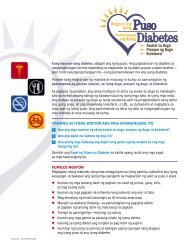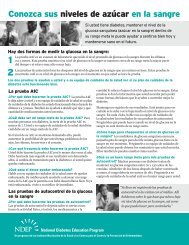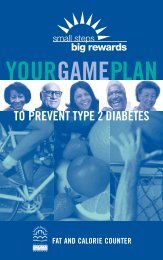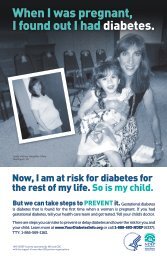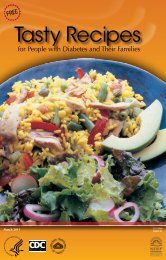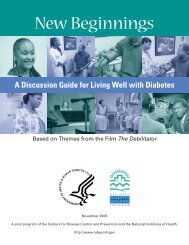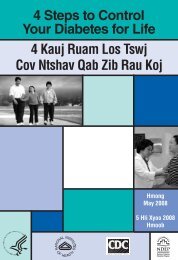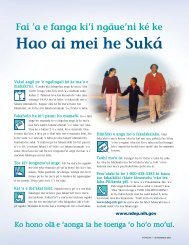Power to Prevent - National Diabetes Education Program - National ...
Power to Prevent - National Diabetes Education Program - National ...
Power to Prevent - National Diabetes Education Program - National ...
You also want an ePaper? Increase the reach of your titles
YUMPU automatically turns print PDFs into web optimized ePapers that Google loves.
What are some of the Complications of <strong>Diabetes</strong>?<br />
Ask: “Can anyone tell us why you would want <strong>to</strong> prevent diabetes? What are some of the possible health<br />
problems, or complications, that diabetes can cause?”<br />
Write answers on the fipchart. Be sure that the following items are mentioned:<br />
Blindness (diabetes is the number one cause of acquired blindness in the U.S.A.)<br />
Kidney damage (diabetes is the number one cause of kidney disease in the U.S.A.)<br />
Nerve damage<br />
Foot problems that can lead <strong>to</strong> amputations<br />
Heart and blood vessel problems (diabetes is a large contribu<strong>to</strong>r <strong>to</strong> the number one cause of<br />
death in the U.S.A.—heart disease and stroke)<br />
Gum disease (or periodontal disease)<br />
Amputations (diabetes is the number one cause of amputations in the U.S.A.)<br />
Who is at High Risk for <strong>Diabetes</strong>?<br />
Ask: “Can anyone tell us what puts a person at increased risk for diabetes?”<br />
Write the risk fac<strong>to</strong>rs on the fipchart. Be sure <strong>to</strong> list the following:<br />
Family member wit diabetes (blood relative)<br />
Older age (type 2 diabetes is more common as people get older). About in 0 people over age<br />
20 years have diabetes; but for people aged 60 and older, in 5 have diabetes.<br />
Being overweight or obese.<br />
Sedentary lifestyle (not much physical activity).<br />
His<strong>to</strong>ry of diabetes during pregnancy (gestational diabetes).<br />
Being a member of certain ethnic group: African American, Hispanic/Latino, American Indian/<br />
Alaska Native, and Asian American and Pacifc Islander.<br />
OPTIONAL: Distribute the <strong>Diabetes</strong> Detection Initiative risk test in Appendix A <strong>to</strong> participants<br />
<strong>to</strong> complete during the session or take home <strong>to</strong> fll out with family members. This risk test helps<br />
identify who is at increased risk for diabetes.<br />
What Can I do <strong>to</strong> Reduce My Risk?<br />
Say: “The good news is that by making small changes in your lifestyle you can reap big rewards in<br />
preventing diabetes. If you already have diabetes, these small changes can add up <strong>to</strong> better blood<br />
glucose control. A national <strong>Diabetes</strong> <strong>Prevent</strong>ion <strong>Program</strong> study found that people at high risk for<br />
diabetes can prevent or delay the onset of the disease by losing 5 <strong>to</strong> 7 percent of their body weight with<br />
healthy eating and 30 minutes of physical activity 5 days per week. In other words: you don’t have <strong>to</strong><br />
‘knock yourself out’ <strong>to</strong> prevent diabetes. The key is that small steps can lead <strong>to</strong> big rewards.”<br />
Give an example: By taking a small step, such as reducing the amount of soda that you drink each<br />
day, or taking the stairs instead of the eleva<strong>to</strong>r <strong>to</strong> go up one foor, you can reap big rewards, such as<br />
helping <strong>to</strong> maintain your weight or <strong>to</strong> control your blood glucose levels.<br />
NDEP <strong>Power</strong> <strong>to</strong> <strong>Prevent</strong> Session 6



